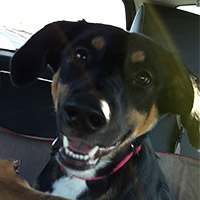Ellie is a well-behaved and calm dog. She achieved that from her natural personality and a lot of training during the puppy years. But I’ve grown suspicious of two things: 1. my training may not have been as effective as I think and 2. I might have trained too much or too strictly.
Note: for this article, I am referring to the “puppy” stages as primarily from about 6 months to 2 years. That is the time period in which I was most focused on obedience training.
1. my training may not have been as effective as I think
I have this suspicion that the results of rigorous and strict training may not fully manifest themselves until adulthood. Another way to think of it is that, puppies may act in a way that doesn’t necessarily indicate their future obedience even though your training is actually working. The reason is because puppies, like children, are more spontaneous, unpredictable, energetic, and driven by their emotions. Your training may be constructing a well-behaved adult dog, but it won’t be fully realized until they’ve grown into their adult mind. The problem is that, if you don’t know this, you may overcompensate and train even harder because you’ve developed increasingly high expectations for how your growing puppy should behave. But expecting that level of consistency in a young puppy will only result in frequent disappointment as they express their high levels of energy in ways that you consider bad behavior.
2. I might have trained too much or too strictly
Due to the misaligned expectations from above, I found myself training extra hard and setting strict ground rules to try and force this expressive young dog into complying with my expectations. The result being that I may have suppressed Ellie’s natural personality. Instead of a more carefree dog, I have a dog that is always looking to me for commands, always slightly on alert, almost too calm and obedient at times. I should have been less serious and more accepting of failure. I should have let things go and moved on to train another time. I may have successfully shaped her into a reliable and obedient dog, but then I continued to drive the point across until she felt powerless to make decisions without my guidance. This is an interesting problem to consider. How do our unique personalities and flaws influence our training? How does that inadvertently affect our dogs? How much of it is misaligned with what we’re actually trying to achieve?
There are many other factors to consider as well. As a new dog owner, I was very excited to test my hand at training and as a result I focused far more on training than play. In a way, it reminds me of the relationships where one parent is known as the disciplinarian while the other is known as the “fun one”. Both are important, but it changes how your child sees with you. I’ve also observed, and been told, about aspects of my own personality that probably played a hand in shaping Ellie as well. I am calm, quiet, rational, level-headed, rarely emotional, and shy. All those traits undoubtedly passed on to Ellie who has spent 99.9% of her life with me. Mimicry is a powerful mammalian behavior and what I see in her may be a reflection of myself. To create a more playful and boisterous dog, I probably need to change how I express my own self in the world. Another facet of my personality is that I am highly observant. I’ve watched Ellie closely her whole life in an effort to shape her behavior and keep her safe, but that level of scrutiny may have reinforced a somewhat paranoid dog. Imagine being studied by a powerful, seemingly omnipotent figure your entire life. I’d imagine that could intensely change how you behave and express yourself.
Obviously, I don’t know if these things are true, but I have internalized this lesson as something to carry over to my next dog. In the meantime, Ellie leads a great life with an owner that is focused on her well-being and happiness. But I am a highly critical person and rarely satisfied with the status quo. I can see paths forward that lead toward improvement and perfection, but I could do with a lesson in accepting failure and relaxing the rules. Especially when the target of that focus is unable to share an opinion or vote on the measures. Sorry Ellie, I’m doing my best!
